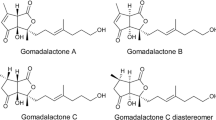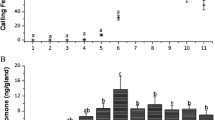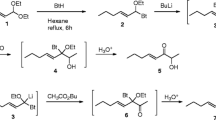Abstract
InNauphoeta cinerea, male calling behavior is associated with sex pheromone release by the sternal glands. The male pheromone that attracts females from a distance is a mixture of 2-methylthiazolidine and 4-ethylguaiacol. It is active at very low concentrations, 0.05 and 0.01 ng, respectively. Two other compounds, 3-hydroxy-2-butanone and 2-methyl-2thiazoline, act at close range, keeping the female in the vicinity of the male. The function of the volatile pheromone and those of previously described contact pheromones are discussed in regard to their possible involvement in the establishment of male dominant-subordinate relationships.
Similar content being viewed by others
References
Bell, W.J., andGorton, R.E. 1978. Informational analysis of agonistic behaviour and dominance hierarchy formation in a cockroach,Nauphoeta cinerea.Behaviour 67:217–235.
Bell, W.J., Gorton, R.E., Tourtellot, M.K., andBreed, M.D. 1979. Comparison of male agonistic behavior in five species of cockroaches.Insect Soc. 26:252–263.
Blum, M.S. 1981. Chemical Defense of Arthropods. Academic Press, New York, 562 pp.
Breed, M.D., Smith, S.K., andGall, B.G. 1980. Systems of mate selection in a cockroach species with male dominance hierarchies.Anim. Behav. 28:130–134.
Brossut, R., andSreng, L. 1985. L'univers chimique des Blattes.Bull. Soc. Entomol. Fr. 90:1266–1280.
Brossut, R., Dubois, P., Rigaud, J., andSreng, L. 1975. Etude biochimique de la sécrétion des glandes tergales de Blattaria.Insect Biochem. 5:719–732.
Charlton, R.E., andRoelofs, L.R. 1991. Biosynthesis of volatile, methyl-branched hydrocarbon sex pheromone from leucine by arctiid moths (Holomelina spp.).Arch. Insect Biochem Physiol. 18:81–97.
Dettner, K., andSchwinger, G. 1980. Defensive substances from pygidial glands of water beetles.Biochem. Syst. Ecol. 8:89–95.
Etievant, P.X., Mona, A., Pham-Delegue, M.H., andMasson, C.J. 1984. Isolation and identification of volatile constituents of sunflowers (Helianthus annuus L.).J. Agric. Food. Chem. 32:503–509.
Ewing, L.S. 1972. Hierarchy and its relation to territory in the cockroachNauphoeta cinerea.Behavior 42:152–174.
Ewing, L.S. 1973. Territoriality and the influence of females on the spacing of males in the cockroachNauphoeta cinerea.Behavior 45:182–303.
Ewing, L.S., andEwing, A. 1973. Correlates of subordinate behavior in the cockroach,Nauphoeta cinerea.Anim. Behav. 21:571–578.
Frattini, C., Bicchi, C., Baretti, C., andNano, G.M. 1976. Volatile aroma constituents of rhubarbs. Part 2.Riv. Ital. Essenze 58:132–135.
Fukui, M., andTakahashi, S. 1983. Studies on the mating behavior of the cockroach,Nauphoeta cinerea (Olivier) (Dictyoptera: Blaberidae) III. Isolation and identification of intermale recognition pheromone.Appl. Entomol. Zool. 18:351–356.
Gottschalk, G. 1986. Bacterial Metabolism, 2nd ed. Springer-Verlag, New York.
Heller, S.R., andMilne, G.W.A. 1980. E.P.A./N.I.H. Mass Spectral Data Base. National Bureau of Standards (U.S.), U.S. Government Printing Office, Washington, D.C.
Idstein, H., andSchreier, P. 1985a. Volatile constituents from papaya fruit (Carica papaya L., var. Solo).Lebensm.-Wiss. Technol. 18:164–169.
Idstein, H., andSchreier, P. 1985b. Volatile constituents from guava (Psidium guajava L.).J. Agric. Food Chem. 33:138–143.
Irvine, W.J., andSaxby, M.J. 1969. Constituents of certain tobacco types. III. Further volatile phenols of Latakia tobacco leaf.Agric. Biol. Chem. 34:2067–2070.
Kamm, J.A., andButtery, R.G. 1984. Root volatile components of red clover: identification and bioassay with the clover root borer (Coleoptera: Scolytidae).Environ. Entomol. 13:1427–1430.
Kamm, J.A., Buttery, R.G., andLing, L.C. 1984. Volatile components of red clover leaves, flowers, and seed pods: Possible insect attractants.J. Agric. Food Chem. 32:254–256.
Kramer, S. 1964. Aggressive behavior in the courtship of cockroachNauphoeta cinerea.Am. Zool. 4:164.
Longhurst, C., Baker, R., andHowse, P.E. 1980. A comparative analysis of mandibular gland secretions in ant tribeTetra morini.Insect Biochem. 10:107–112.
MacFaddin, J.F. 1980. Biochemical Tests for Identification of Medical Bacteria, 2nd ed. Williams and Wilkins, Baltimore, pp. 308–320.
MacGovern, T.P., andLadd, T.L., Jr. 1981. 2-Methoxyphenols, 1,2-dimethoxybenzenes, and 1,3-benzodioxoles as attractants for the northern corn rootworm (Coleoptera: Chrysomelidae).J. Econ. Entomol. 81:826–829.
Menon, M. 1981. Morphological evidence for probable secreting site for the pheromone “Seducin” in males ofNauphoeta cinerea. I. Light microscope studies.J. Morphol. 168:229–237.
Moore, A.J. 1988. Female preferences, male social status, and sexual selection inNauphoeta cinerea.Anim. Behav. 36:303–305.
Moore, A.J. 1989. Sexual selection inNauphoeta cinerea: Inherited mating preferences?Behav. Genet. 19:717–724.
Moore, A.J. 1990a. The inheritance of social dominance, mating behaviour, and attractiveness to mates in maleNauphoeta cinerea.Anim. Behav. 39:388–397.
Moore, A.J. 1990b. Sexual selection and genetics of pheromonally mediated social behavior inNauphoeta cinerea (Dictyoptera: Blaberidae).Entomol. Gener. 15:133–147.
Nishida, R., Sato, R., Kuwabara, Y., Fukami, H., andIshii, S. 1976. Female sex pheromone of German cockroachBlattella germanica (L.) (Orthoptera: Blattellidae) responsible for male wing-raising. II. 29-hydroxy-3,11-dimethyl-2-nonacosanone.J. Chem. Ecol. 2:449–455.
Perry, A.S. 1961. Metabolism of insecticides by various insect species.J. Agric. Food Chem. 00:266–272.
Roth, L.M., andDateo, G.P. 1966. A sex pheromone produced by the male of the cockroachNauphoeta cinerea.J. Insect Physiol. 12:255–265.
Roth, L.M., andWillis, E.R. 1952. A study of cockroach behavior.Am. Midl. Nat. 47:66–129.
Schal, C., andBell, W.J. 1983. Determinants of dominant-subordinate interactions in males of the cockroachNauphoeta cinerea.Biol. Behav. 8:117–139.
Schal, C., Burns, E.L., Jurenka, R.A., andBlomquist, G.J. 1990. A new component of the female sex pheromone ofBlattella germanica (L.) (Dictyoptera: Blattellidae) and interaction with other pheromone components.J. Chem. Ecol. 16:1997–2008.
Sirugue, D. 1992. Comportement sexuel et hiérarchie chezLeucophaea maderae etNauphoeta cinerea (Dictyoptera, Blaberidae). Identification et rôle des phéromones sexuelles mâles. Thèse de Doctorat, Université de Bourgogne.
Sheehan, J.C., Beck, C.W., Henery-Logand, K.R., andRyan, J.J. 1956. The reaction of phthaloylglycyl chloride with 2-methyl-2-thiazoline.J. Am. Chem. Soc. 78:4478–4481.
Smith, S., andBreed, M. 1982. Olfactory cues in discrimination among individuals in dominance hierarchies in the cockroach,Nauphoeta cinerea.Physiol. Entomol. 7:337–341.
Sreng, L. 1979. Phéromones et comportement sexuel chezNauphoeta cinerea (Olivier) (Insecte, Dictyoptère).C.R. Acad. Sci. 289:687–690.
Sreng, L. 1983. Comportement sexuel et communication chimique chez les blattes. Le cas deNauphoeta cinerea et des genres voisins. Thèse de Doctorat d'Etat, Université de Dijon.
Sreng, L. 1984. Morphology of the sternal and tergal glands producing the sexual pheromones and the aphrodisiacs among the cockroaches of the subfamily Osyhaloinae.J. Morphol. 182:279–294.
Sreng, L. 1985. Ultrastructure of the glands producing sex pheromones of the maleNauphoeta cinerea (Insecta, Dictyoptera).Zoomorphology 105:133–142.
Sreng, L. 1991. Seducin, male sex pheromone of the cockroachNauphoeta cinerea: Isolation, identification, and bioassay.J. Chem. Ecol. 16:2899–1912.
Takahashi, S., andFukui, M. 1980. Studies on the mating behavior of the cockroachNauphoeta cinerea Olivier. 2. Wing raising stimulant in cuticular wax.Appl. Entomol. Zool. 15:159–166.
Takahashi, S., andFukui, M. 1983. Studies on the mating behavior of the cockroachNauphoeta cinerea Olivier (Dictyoptera: Blaberidae). 4. Synthesis and biological activity of nauphoetin and related compounds.Appl. Entomol. Zool. 18:257–360.
Welch, R.C., Johnston, J.C., andHunter-George, L.K. 1982. Volatile constituents of the muscadine grape (Vitis rotundifolia).J. Agric. Food Chem. 30:681–684.
Wheeler, J.W. 1977. Properties of compounds used as chemical signals, pp. 61–70,in D. Müller-Scharze and M.M. Mozell, (eds.). Chemical Signals in Vertebrates. Plenum Press, New York.
Yamanishi, T., Michiko, N., andNakatani, Y. 1970. Flavor of green tea. VIII. Flavor constituents in manufactured green tea.Agric. Biol. Chem. 34:599–608.
Author information
Authors and Affiliations
Rights and permissions
About this article
Cite this article
Sirugue, D., Bonnard, O., Le Quere, JL. et al. 2-Methylthiazolidine and 4-ethylguaiacol, male sex pheromone components of the cockroachNauphoeta cinerea (dictyoptera, blaberidae): A reinvestigation. J Chem Ecol 18, 2261–2276 (1992). https://doi.org/10.1007/BF00984949
Received:
Accepted:
Issue Date:
DOI: https://doi.org/10.1007/BF00984949




